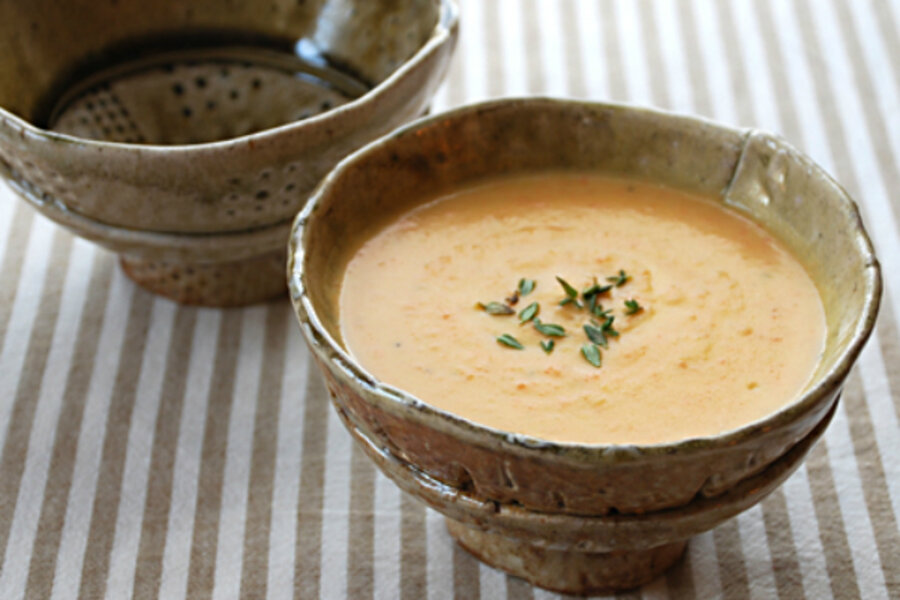French carrot soup
Loading...
The thing that keeps me coming back to French food is its perfect simplicity. And yes, classic French cuisine is littered with plenty of complex creations, all wonderful, to be sure. But what really wows me is how they can take a half dozen or so ordinary ingredients and in a few simple steps make something perfect.
The French get food. They celebrate it. Much as their wines are named for the regions where the grapes are grown, many French dishes are named for their places of origin. According to "Williams-Sonoma Collection: French," a gem of a cookbook, Crécy-en-Ponthieu in northern France is known for producing some of the country’s best carrots. Hence, the name for this creamy soup. According to other sources, the town is even better known for a crucial battle in the Hundred Years' War in 1346, a battle that did not end well for the French. If I have to choose between dusty history and this subtle, satisfying potage, give me the soup, please.
A soup by any other name
Depending on who’s doing the counting, the French have either three or four distinct categories of soups. At one end of the scale is consommé, a clear broth that may or may not contain garnishes. At the opposite end is soupe, a “thick, hearty mélange with chunks of food,” according to epicurious.com. Potage falls somewhere in the middle, a thick, creamy soup that is often puréed. The Williams-Sonoma cookbook here calls out another category, bisque, a smooth, velvety soup most often made with lobster or shellfish and cream.
One notable potage is even simpler than the one I’ve made this week – Julia Child’s potage parmentier, or leek and potato soup as it is simply called in her classic cookbook, "Mastering The Art of French Cooking." Its ingredients are water, potatoes, leeks, butter, cream, and salt. Not even chicken stock. Whatever else she served, her husband’s meal began with this simple soup every night.
Potage Crécy [poh-TAHZH creh-SEE] is nearly as elegantly austere and every bit as soul satisfyingly delicious. Even though carrots star in this dish, they don’t dominate. No single ingredient does – not the chicken stock, the potatoes, the leeks, cream or even the fresh thyme. Instead, they all work together to create something better and more delicately flavored than the ingredients list might suggest. As always, the fewer the number of ingredients in a dish, the harder each has to work. For the carrots, even if you can’t get them from Crécy, choose carefully. Go for slender, fresh looking carrots, preferably organic. Larger, thicker carrots can often be tough. For chicken stock, homemade is best. If that’s not possible, choose a good quality commercial broth over bouillon cubes; I used an organic, free range chicken broth from Trader Joe’s.
Potage Crécy
Makes 4 cups (3 to 4 first course servings)
Adapted from Williams-Sonoma Collection: French
1 tablespoon unsalted butter
1 tablespoon olive oil
1 leek, white and tender green parts, rinsed and sliced [see Kitchen Notes]
3/4 pounds carrots [about 5 or 6], diced
3/4 pounds russet or Yukon gold potatoes, diced
2-1/2 cups chicken stock or broth
1-1/4 teaspoons fresh thyme leaves [or 1/2 teaspoon dried]
1 cup half-and-half
1 tablespoon fresh lemon juice
1/4 teaspoon freshly grated nutmeg
salt and freshly ground black pepper, to taste [see Kitchen Notes]
additional fresh thyme leaves, for garnish [or finely chopped flat-leaf parsley – see Kitchen Notes]
1. Heat a dutch oven or large soup pot over medium heat. Melt butter and combine with olive oil. Add leeks and sauté, stirring occasionally, about 4 minutes. Add potatoes and carrots and sauté for about 5 minutes, stirring occasionally.
2. Add chicken stock and bring to a simmer. Add thyme, cover the pot and simmer until carrots and potatoes are tender, about 25 minutes. Purée the soup in a blender or food processor, in batches, if necessary. [Alternatively, use a handheld immersion blender in the pot.]
3. Return puréed soup to the pot. Add half-and-half, lemon juice and nutmeg. Season with salt and pepper to taste [using a light hand, depending on how salty your chicken stock or broth is]. Bring to a simmer until just heated through. Ladle soup into bowls and garnish with fresh thyme leaves or parsley. Serve.
Kitchen Notes
Cleaning leeks. Leeks like to grow in sandy soil, so you need to clean them carefully. Slice off root end and most of the green tops. Slice leeks in half lengthwise. Rinse under running water, fanning layers to wash out any trapped grit. When they’re cleaned, slice crosswise in 3/4-inch pieces.
Black pepper? White pepper? Many recipes, including the original for this soup, call for white pepper rather than black. And while white pepper is slightly milder in taste than black, the difference is minimal; the choice is usually based on visual aesthetics, with white pepper being specified for light colored foods. You see this a lot in fish recipes. Personally, I like the look of dark flecks of black pepper on most pale foods – especially with fish, which can otherwise look bland or sickly to me. So it’s your call, but I’m just as happy to stock one kind of peppercorns.
Keep it fresh, garnishwise. As the recipe says, you can substitute dried thyme for fresh in this soup. But if you use dry when cooking it, do not use it for your garnish; opt for chopped fresh parsley instead. The fresh thyme leaves (my first choice) give a delicate, slightly minty taste and a nice little crunch. Dried herbs need to cook in foods to soften and release their flavors; they fail miserably as garnishes.
Related post on Blue Kitchen: Sweet potato vichyssoise








